1 - 15 of 17 records
Salzburg et Carinthis

Description: This is a detailed copper engraved map depicting Salzburg, Austria and surrounding area. The map is filled with a lot of geographic details on cities, towns, rivers, lakes, mountains, and forests. The map is adorned with a decorative title cartouche. Cities, towns and other sites on this map: Seebruck, Paembrug, Rot (Rott am Inn), Reit (Raiten), Gronpach, Ettnhausn, and Tresperg (Trostberg), Lauffen (Laufen), Bergtolsgade (Berchtesgaden), Paling (Palling), Glanegk, S. Seno, Durnperg, S. Valtein, Germany, Kufsteyn (Kufstein), Griespach, Spittall, Kiezpuchl (Kitzbuhel), Brixem (Brixen im Thale), Rotenburg (Rattenberg), Hieburg, Krumler Taurn, Velbra, Vyrgijn (Virgen), Kyrburg, Dravus Flu (Drava River), Lienez (Lienz), Draburg (Oberdrauburg), Greifnburg (Greifenburg), Typliach, Katschach (Kotschach), S. Nonafus, Droplach (Tropolach), Cerunburg, Moderndorff, Saxnfelt, Spittal (Spittal an der Drau), Kellerberg, Federburg, Weißestein (Weißenstein), Osiach (Ostriach), Werd (Maria Wörth), Clangfurt (Klagenfurt), Czwaikirch, Glanach (Glainach), Kappl (Eisenkappel-Vellach/ Bad Eisenkappel), S. Philip, Wildnsteyn, Vockmark (Völkermarkt), Maijsnburg, S. Walpurg (St. Walburgen), Harnperg, S. Lamprecht, Stayn, Fraunbrug, Newmark, Scheyfling (Scheifling), Tyrnstayn, Altn Hosn (Althofen), Waytring (Wieting), Eberstayn (Eberstein), S. Veit (Sankt Veit an der Glan), Hardeck, S. Peter, Gurck (Gurk), S. Loerns, Melnycz, Racz, Klausegk, S. Veyt, Muraw (Murau), Halflat (Hallstatt Lake), Lamerding, Ifschel (Bad Ischl), Falkensteyn, Geimund (Gmunden), Frankirche, Masee, Talge, Aygn, S. Egidy, S. eter, Abtenew, S. Michael (Sankt Michael im Lungau), Velachertaurn, Mattsee (Mattsee), Saltzburg (Salzburg), Werffen (Werfen), Gradneck, Veld Dirchn, Mylstat, Hohnpruk, Mijlpag, Raurisser Taurn, Velachertaurn, Stal, Velach, CasteinTaurn, Pod, Hoss, Rauris, Dachsepach, Goldeckherhoff, ZaleZach Fl. (), Iorg, Zell (Zell-am See), Lofer, Austria, Daufers (Tures/Taufers), Bruneck (Bruneck/Brunico), Doblach (Toblach/Dobbiaco), S. Magdalena Vels (Santa Maddelena/Sankt Magdelena), Palussa (Paluzza), Adauur, Ponte Basse (Pontebba), Klein Taruys, Italy, Krayeck (Kranjska Gora), Porta des Pless, Slovenia Jodocus Hondius (1563-1612) was the founder of the family business of publishing and cartography started in Amsterdam, as well as one of the most important engravers of his time. Petrus Bertius was a Flemish theologian, historian, geographer, and cartographer born in Beveren (Flanders). In 1593 he became a librarian and professor of mathematics at the University of Leyden.
Member of: Antiquarian Maps Collection (1603-1863)
Resource Type: cartographic
Acquisitiones Pyrrhi Epirotarum Regis sicut in Plutarcho (1739)
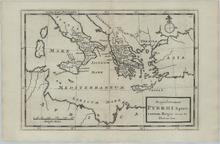
Description: Copper engraved historic map showing the Kingdom of Pyrrhus of Epirus, based on the sources of Plutarch. The map depicts the Southern tip of Italy, Sardinia, Corsica, Greece, Crete, the Northern tip of the African Continent, Croatia, Albania, Macedonia, and Turkey. The map is filled with a lot of geographic details concerning place names in Latin, Rivers, Mountains, and Islands. The title is inside a simple cartouche. Cities, Rivers, Towns, and Seas shown: Italia (Italy), Illyricum (Present day Croatia, Bosnia and Herzegovina, and Albania), Roma (Rome), Samnites (People of South-Central Italy), Ferentium (Absorbed by Modern-day Viterbo), Asculum (Ascoli Satriano), Beneventum (Benevento), Apulia, Messapia (Salento), Hydruntum (Otranto), Heraclea Lucania (Roman town abandoned before the 19th Century), Magna Graecia, Mare Mediterraneum (Mediterranean Sea), Castella Mamerti Norum, Messana (Messina), Eryae, Agrigentum (Agrigento), Sicilia (Sicily), Leontium, Syracuse, Carthago (Carthage), Africa, Libicum Mare, Siculum Mare, Tarentum (Taranto), Graecia (Greece), Nimphea, Pieria Megares, Macedonia, Epirus (Modern-day Greece and Albania), Edessa, Paeonia (Paionia), Chaonia (Modern day Western Greece), Passaron, Berea (Veria), Coreyra Island, Tresprotia, Berenicea, Ambracia (Arta), Dodona (Greek city that dwindled sometime after 431 AD), Aegea, Thessalia (Thessaly), Peneus F., Pineios River), Amphilechia, Amphilechia, Aetolia, Phocis, Attica, Athenae (Athens), Nysea, Corinthus (Corinth), Peloponnesus (Peloponnese), Argos, Megalopolis (Megalopoli), Neapolis, Cilarbis, Tegea (Alea), Lernae, Sparta, Thracia, Troja (Troy), Asia, Creta I. (Crete Island), Aptera, and Gortyna (Gortyn). The source publication is: Geographia antique, Latinorum et Graecorum, tabulis XXXII novis & accuratis expressa, translated: Thirty-two new and accurate maps of the geography of the ancients, as contained in the Greek and Latin Classics. It was printed and sold in 1739 in London by Thomas Bowles. Herman Moll was a Dutchman bookseller, geographer and engraver. Around 1678 he moved to London where for a while he continued as an engraver. Later, he started his own businesses a map publisher and by the turn of the century had become the most prominent map publisher in the country. He published atlases and loose maps of all parts of the world many of which were highly decorative. In 1724 he published his 'New Description of England and Wales', an atlas of the English and Welsh Counties. He had many interesting friends including Daniel Defoe, Jonathan Swift (for whom he provided maps for Robinson Crusoe and Gulliver's Travels), explorers William Damier and Woodes Rogers, and the scientist Robert Hooke.
Member of: Antiquarian Maps Collection (1603-1863)
Resource Type: cartographic
JM-021: Mr. American reactionary abroad tries to change the opinion of Europe
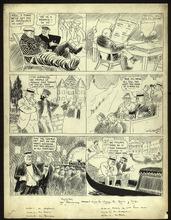
Description: Editorial cartoon depicting an American visiting places such as France, Germany, and Italy and hearing praise for Roosevelt, which the American does not agree with.
Member of: McCutcheon Editorial Cartoons - ALL (Collection)
Resource Type: Still Image
JM-164: Will there be enough to go round?
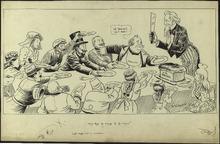
Description: This cartoon depicts Uncle Sam trying to divide "U.S. Bread" among various nations. In 1915, World War I was being fought in Europe, but the United States was maintaining a neutral position. Despite its neutrality, the United States supplied resources and arms to nations during the war. All of the countries sitting at the table are nations who lobbied for resources from the United States during the war. England is attempting to block Germany's chance of receiving resources from Uncle Sam. This is representative the attempts of the British government to limit the United States aid to Allied Powers, most often England. The United States is also sitting at the table, looking worried about sharing the beard with other nations. The United States distributing more resources than it could afford was a fear for many Americans in the 1910s. (Summary created by Mary Delano, MU History Intern, Spring 2018)
Member of: McCutcheon Editorial Cartoons - ALL (Collection)
Resource Type: Still Image
JM-315: Storm clouds on the Axis front

Description: Mussolini, Hitler, Hirohito see powerful U.S. fists.
Member of: McCutcheon Editorial Cartoons - ALL (Collection)
Resource Type: Still Image
JM-W024: In the Allied camp

Description: Editorial cartoon depicting Churchill and FDR looking at a map of Europe in the top panel. In the bottom panel, Hitler, Togo, and Mussolini worry about the plane production in the U.S. as the "unpredictable" factor compared to their U-boats.
Member of: McCutcheon Editorial Cartoons - ALL (Collection)
Resource Type: Still Image
JM-W022: After you, my dear Air Force
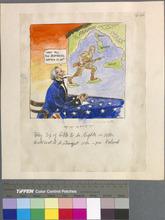
Description: Editorial cartoon depicting Uncle Sam staring at a map of Italian islands where a U.S. soldier is stepping. He says to wait for the bombers to "soften it up."
Member of: McCutcheon Editorial Cartoons - ALL (Collection)
Resource Type: Still Image
JM-088: Another case of hyphenitis
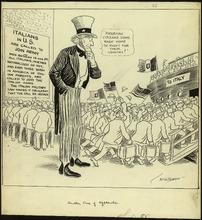
Description: Editorial cartoon depicting Uncle Sam watching men board ships "To Italy." A sign on a brick wall behind Uncle Sam calls for Italian-Americans to join the Italian army.
Member of: McCutcheon Editorial Cartoons - ALL (Collection)
Resource Type: Still Image
JM-292: Putting a premium on aggression and treaty breaking
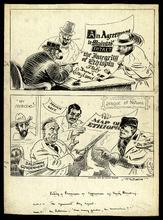
Description: Editorial cartoon depicting Italy, France, and Britain pledging to help Ethiopia, then carve it up.
Member of: McCutcheon Editorial Cartoons - ALL (Collection)
Resource Type: Still Image
JM-289: Dancing to the spring song
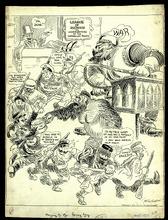
Description: Editorial cartoon depicting men representing nations dancing around "war" organ grinder. The League of Nations watches from a window.
Member of: McCutcheon Editorial Cartoons - ALL (Collection)
Resource Type: Still Image
JM-079: A good New Year's resolution

Description: Editorial cartoon depicting a hand writing out a check from the National Bank of Chicago for the "Italian Relief Fund." Behind the hand, figures representing New York, St. Louis, California, and Chicago all carry bags or baskets labeled "Relief for Italy."
Member of: McCutcheon Editorial Cartoons - ALL (Collection)
Resource Type: Still Image
Turcicum Imperium
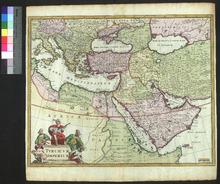
Description: Second state of the map; the earlier state included L'Huilier's credit in the lower right border.,On verso: Blank
Member of: Venable Maps
Resource Type: cartographic
A New and Correct Map of Italy

Description: Appeared in Moore's A new and complete collection of voyages and travels (1778),On verso: Blank
Member of: Venable Maps
Resource Type: cartographic
Map of Central Europe
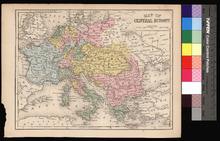
Description: Appeared in Mitchell's New Intermediate Geography (published in various editions between 1869 and 1901). Different editions were produced for different states.,On verso: Text: Great Britain and Ireland (Wales, Ireland)
Member of: Venable Maps
Resource Type: cartographic
Bible. Latin. O. T. II Chronicles. [leaf]
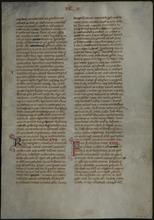
Description: "4to (26.3 x 18.3 cm, 10.375 x 7.25"). [1] f. Perhaps more important than European universities as a market for Bible production were the friars: the Dominicans and Franciscans. Thus Bologna, not possessing a faculty of theology like Paris, but having the second most important Dominican house, was also, next to Paris, the most prolific producer of Bibles. This leaf in many ways could have come from Paris, but the fact of prominent chapter divisions, arguing also for a date later than ca. 1225, and the fact that the top line of text is above the top line of ruling point to southern Europe. The text is II Chronicles 16:4-18:34, including the end of the reign of Asa, king of Judah, and part of the reign of Jehoshaphat. It is worthy of note that chapter XVIIII in this manuscript begins with 18:28 in the standard numbering.nnThis leaf is written in brown ink in a compact and rounder Gothic, in two columns of 48 lines, ruled in lead, with the prickings still present on the inside edge. The running headers are in red, as are the numbers heading each chapter; chapters also bear decorative initials: a green two-line R with red tracery for chapter XVII, a four-line red F with purple tracery for chapter XVIII (both on the recto), and (on the verso) a four-line red I with red tracery. In some places the text has been erased and corrected in black ink in a more angular hand. In the (two) left margins are three nota (?) marks consisting of a single stroke with two or three dots over it. nnProvenance: Ex-Zion Research Foundation (later known as the Endowment for Biblical Research); very likely to Zion from Ege.nnSome light soiling or staining in the margins. A closed cut, appr. 2.5 cm, 1" in length, from outside margin into text without loss.",Full pdf available, https://dl.mospace.umsystem.edu/mu/islandora/object/mu%3A439255/datastream/PDF/view
Member of: Private Collection of Antiquarian Books and Manuscripts
Resource Type: Text
Pagination
- Page 1
- Next page